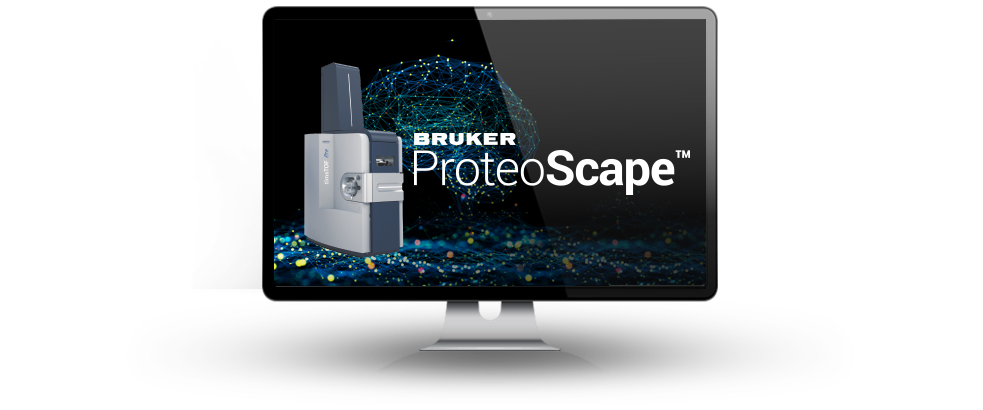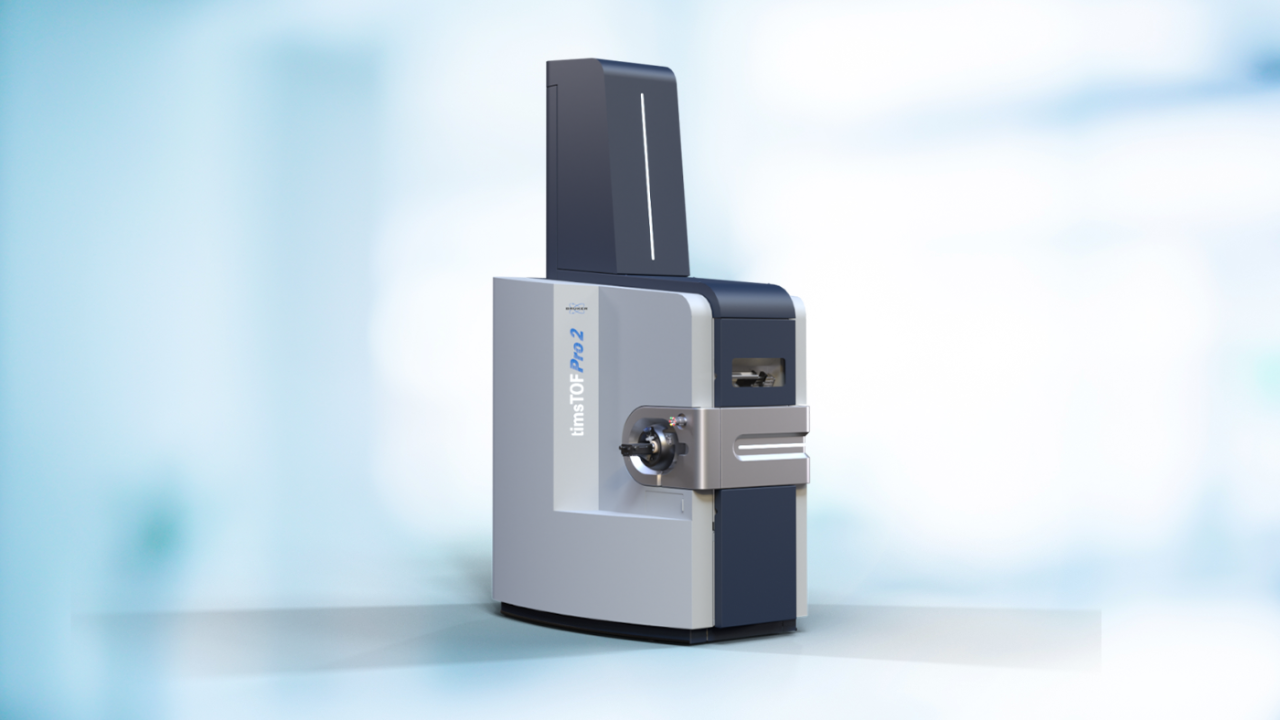Bruker ProteoScape™
Immediate Results!
Real-time results = efficiency


Real-time results to inform you of current instrument and sample status
4D-Proteomics™ with real-time search results and smart acquisition
Break the data analysis bottleneck by integrating real-time database search and smart acquisition provided by Bruker ProteoScape™.
Universally available
- All current and future timsTOF Pro, HT, fleX and SCP platforms are accessible with Bruker ProteoScape™
4D-Proteomics™
- CCS-enabled data is rich, even so real-time database search capabilities are a reality with Bruker ProteoScape™ including PTMs like phosphorylation
Massive parallelization with GPU power
- Bruker ProteoScape™ is GPU-powered, provides massive compute power across thousands of CUDA cores
Bruker ProteoScape™ data review
- View the intricate details of your data from the high level experimental information to a specific fragment ion spectrum of interest with confidence from the integrated viewer onboard of all Bruker ProteoScape™ boxes
Smarts
- Bruker ProteoScape™ is smart, where a user defined qualification of proteins or peptides at the end of a sample acquisition determines the progression of your sample queue, checks suitability, saves precious samples, expensive consumables and instrument time
Benefit from time and cost savings
- No more worrying about injecting those precious samples
- No more worrying of wasted instrument time
- No more worrying about those samples with expensive reagents and sample preparation, only to inject on a poor performing system
- No more waiting for the QC runs to determine system suitability
- No more waiting for search results during method development
“Innovative software tools are a necessity to address unanswered biological questions with mass spectrometry. The trapped ion mobility functionality and the robustness of the timsTOF Pro offer unique bottom-up proteomics capabilities that can be effectively used to study many diseases.”
Professor John Yates III, the Ernest W. Hahn Professor at The Scripps Research Institute in La Jolla, California
TIMScore™ – Machine Learning and CCS exploited for better FDR
TIMScore™ provides the greatest number of PSM, peptide and protein identifications by enabling the CCS dimension for true 4D-Proteomics™.
The Bruker ProteoScape™ search algorithm is run as normal, combined with comparison of the predicted and measured CCS values and calculating a TIMScore™ for the top 5 peptide candidates for each spectra.
The TIMScore™ benefit is realized during the peptide-validation and False Discovery Rate (FDR) estimation steps. In a non CCS-enabled algorithm, only two dimensions can be utilized to estimate the FDR rate, and so a discriminate line is fit to a 1% error (Panel A) to distinguish forward and reverse peptide candidates. With TIMScore™, and the extra CCS dimension, the peptide-candidates can be vectorized in 3 dimensions (Panel B) allowing a discriminate contoured plane to be applied to achieve the same 1% error.
Applying a discriminate plane provides increased accuracy and precision, helping to validate formerly poorly scoring PSMs in the standard two dimensions.
TIMSrescore™- ML powered, data-driven rescoring workflow for dda-PASEF®
The TIMSrescore™ workflow in Bruker ProteoScape™ allows users to take advantage of the timsTOF-trained and optimized machine learning prediction models for CCS, retention time and fragment ion intensity utilized in the tims2rescore package to maximize data value from dda-PASEF® acquisitions.
The new timsTOF MS2PIP spectrum prediction models, IM2Deep, a new deep learning-based peptide ion mobility predictor and DeepLC, a retention time predictor, are combined to perform ultra-sensitive peptide identification rescoring with Mokapot. The result is that you get more peptide IDs at the same false discovery rate (FDR) threshold.
The TIMSrescore™ workflow is ideal for challenging proteomics identification workflows, such as PTM identification, proteogenomic and immunopeptidomics.
More Information:
"My team and I are pleased with the enthusiastic uptake of our rescoring workflow MS2rescore by the proteomics community over the past 5 years. Through our collaboration with Bruker and the integration in the ProteoScape software, we are thrilled to expand MS2rescore to timsTOF users broadly, allowing our advanced, machine learning-based informatics approaches to help life sciences researchers maximize the value of their proteomics data."
Lennart Marten, Ph.D., Associate Department Director Bioinformatics at VIB – U of Ghent Center for Medical Biotechnology, Ghent, Belgium
BPS Novor – de novo sequencing at the speed of PASEF®
To further discoveries in immunopeptidomics, metaproteomics and other applications where de novo sequencing is needed, we developed BPS Novor together with Rapid Novor Inc.. Our solution provides the quickest, most accurate de novo sequencing results for timsTOF data with all the advantages of Run & Done.
BPS Novor was trained and optimized on greater than >1,780,000 spectra from the timsTOF platform including a variety of non-tryptic enzymes, to build a generalized scoring model. It is capable of processing on average >1000 spectra/second, lending itself for real-time de novo sequencing on the timsTOF platform. BPS Novor consistently outperforms standard Novor and Software A on a variety of datasets.
BPS Novor does not show a noticeable bias for digestion specificity or species and is 20x faster than competing products.
Combined with PASEF® technology on the timsTOF platform, Bruker ProteoScape™ and BPS Novor provide enhanced sensitivity for real-time de novo sequencing for a variety of applications including immunopeptidomics.
TagGraph – automated open modification discovery made easy
Open modification searches have revolutionized peptide identification in mass spectrometry-based proteomics, yet adoption remains slow due to computational complexity and integration challenges. TagGraph has now been seamlessly integrated into Bruker ProteoScape™, providing researchers with a powerful yet user-friendly solution.
With just a few clicks, TagGraph aligns de novo sequencing results from BPS Novor with sequence databases, intelligently introducing modifications and amino acid substitutions to uncover modified peptides with high confidence. Its efficient exploration of vast search spaces ensures precise peptide identification, localization, and scoring.
Thanks to BPS’s intuitive workflow tools, researchers can now run de novo sequencing and TagGraph with minimal parameter setup—no complex optimizations required—for all data-dependent acquisition (DDA) proteomic experiments on the timsTOF platform. This seamless integration makes the discovery of amino acid modifications, sequence alterations, and proteolytic processing a routine part of proteome analyses, empowering scientists to push the boundaries of proteomics with ease.
“De novo searches have been a critical aspect in my labs research for many years, the ability to have an algorithm that delivers results with accuracy and precision at the speed of acquisition means we can assess immunopeptidomics samples at scale and in real time. This has major implications in how fast my group can translate research findings into actionable information, and it pushes this workflow ever closer to delivering clinical impact of these analyses on an unprecedented timescale.”
Professor Anthony W. Purcell, Head of Immunoproteomics Laboratory, Monash University, Melbourne, Australia
Spectronaut directDIA+ workflows streamlined on Bruker ProteoScape™
Bruker ProteoScape™ (v >2024b) has integrated the Spectronaut module, allowing users to access the directDIA+ workflow for library-free analysis of dia-PASEF®. Take advantage of the combined efficiency of Run & Done processing with the sensitivity and quantitative accuracy provided by the gold standard for DIA analysis.
BPS utilizes the same stream mechanism for real-time stream MS and DIA frames from the acquisition PC. At the end of the acquisition the user defined directDIA+ workflow is then triggered allowing library free analysis of dia-PASEF® data. This automation provides users the opportunity to explore and validate the data quality on an injection-to-injection basis.
At the end of the project users can trigger a project wide quantitative analysis to obtain a singular false-discovery-rate controlled perspective of their whole project. Users are also able to download the SNE files (single run or project wide) and utilize standalone Spectronaut for detailed visualization, post-processing and customized reports.
dia-PASEF® workflows streamlined on Bruker ProteoScape™ with TIMS DIA-NN
Bruker ProteoScape™ is capable of processing dia-PASEF® workflows utilizing a customized version of the popular DIA-NN (DIA by Neural Networks) software from the Lilley, Rasler and Demichev labs.
TIMS DIA-NN enables reliable, robust, and quantitatively accurate large-scale experiments. Bruker ProteoScape™ utilizes the same stream mechanism for dia-PASEF® workflows, streaming in real-time MS and DIA frames from the acquisition PC to the Bruker ProteoScape™ box. These dia-PASEF® data are processed and stored on the Bruker ProteoScape™ box. At the end of the acquisition a spectral library search is triggered, and the results recorded. TIMScore™ powered DDA search results can be easily utilized to build spectral libraries or spectral libraries can be imported from other popular tools.
At the end of the project the users can trigger match-between-runs analysis to view a quantitative profile across projects. This provides users an integrated environment for PASEF® and dia-PASEF® data analysis.
More information:
"Our ongoing collaboration with Bruker to tailor DIA-NN to a streamlined processing tool for dia-PASEF® data with a CCS focus has been really rewarding. It simplifies and accelerates identifying and quantifying thousands of proteins in even very short gradients. We are pleased that within our close collaboration with Bruker, the vendor-integrated version of DIA-NN called TIMS DIA-NN now becomes part of the Bruker ProteoScape™ bioinformatics platform."
Prof. Dr. Markus Ralser, Einstein Professor of Biochemistry at Charité, Berlin, Germany
Full-fledged database search in less than 5 ms
Blazing search speed with uncompromised search results.
A) Protein ID from replicate DDA runs of a human cell lysate using Bruker ProteoScape™ for real-time results and benchmarked against MaxQuant
B) Peptide ID from replicate DDA runs of a human cell lysate using Bruker ProteoScape™ for real-time results and benchmarked against MaxQuant
C) Bruker ProteoScape™ and MaxQuant identify 97% of the same proteins and nearly 90% of the same peptides.
More information:
Bruker ProteoScape™ provides consistent results obtained from the real-time search, identical to offline search of the same data. Since the database search algorithm is run on the GPU, the search times are negligible compared to CPU based searches.
In addition to real-time search the opportunity to search a larger space for specific applications, including peptidome studies, becomes reality. Bruker ProteoScape™ benchmarked against the gold standard in DDA searches performs as good or better.
Saves HOURS on LFQ workflow with real-time aided ID
Take advantage of the real-time identification to drastically reduce the required time for dda-PASEF® label-free quantitation (LFQ) with match-between-runs (MBR).
- Uses TIMScore™ for CCS enhanced IDs
- Typically, 1/20th acquisition time to perform quant
- SAVE massive amounts of time using Bruker ProteoScape™
Easily identify poor samples and re-acquire them with Run & Done on Bruker ProteoScape™ before starting the quantitative portion of your workflow. Our IM filtered XIC based quantitative workflow is powered by the Census algorithm (https://doi.org/10.1002/0471250953.bi1312s29).
Videos
“Real-time results delivered by the Bruker ProteoScape™ box on our timsTOF Pro has been a huge time saver. This allows us to develop methods in real-time, inform on LC and instrument performance and overall a major gain in efficiency.“
Sebastian Vaca, Ph.D., Research Scientist, Proteomics Platform at the Broad Institute of MIT and Harvard (Carr Lab), Cambridge, USA
For Research Use Only. Not for use in clinical diagnostic procedures.

